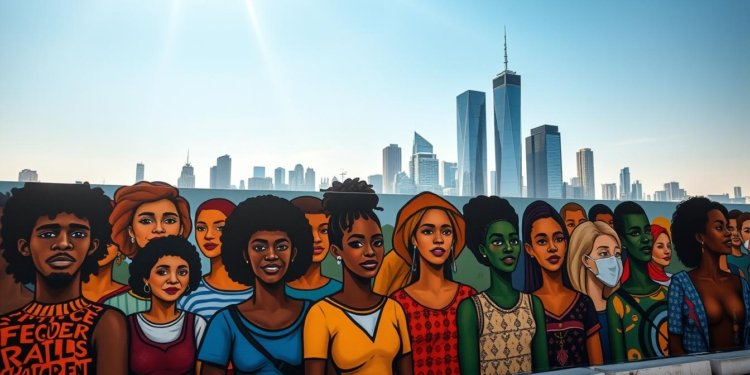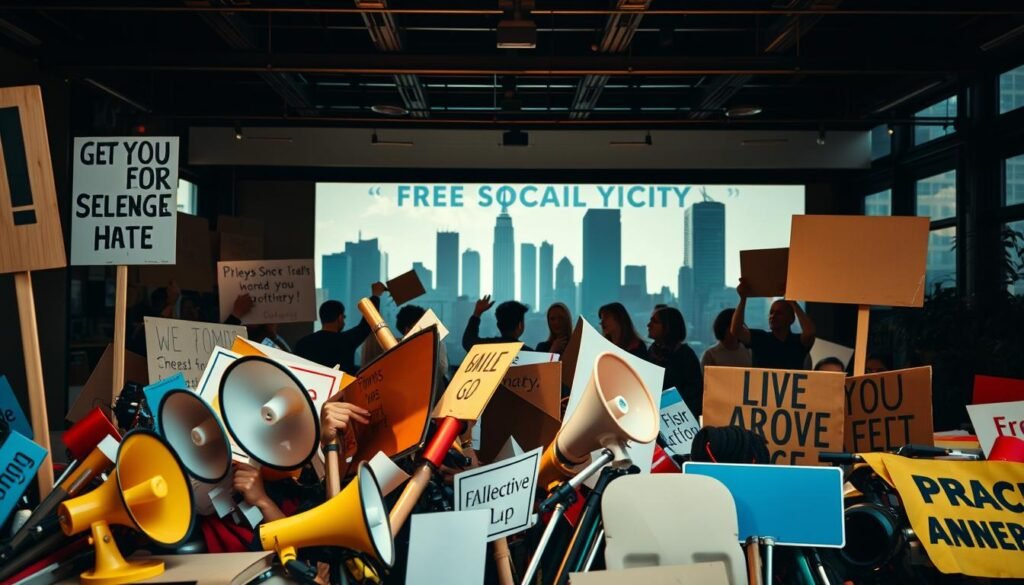What if the key to reducing human suffering lies not just in helping individuals, but in reshaping the systems around them? Social justice advocacy answers this challenge by addressing inequalities at their roots. It pushes for fairness in public health, mental health, and broader community structures.
At its core, this work focuses on systemic change. Advocacy means altering environments to support marginalized groups. Oppression occurs when power imbalances suppress certain people. True progress comes from empowering both individuals and society as a whole.
Professionals across fields recognize advocacy as an ethical duty. From policy reforms to behavioral health initiatives, collective action drives meaningful impact. The goal? A world where equity isn’t an exception—but the standard.
Key Takeaways
- Advocacy creates systemic change by altering environments.
- Oppression stems from power imbalances in social structures.
- Equity in public and mental health requires collective effort.
- Communities thrive when systems support all members fairly.
- Professionals have an ethical role in advancing justice.
What Is Social Justice Advocacy? Defining the Movement
Systems don’t change by chance—they transform through deliberate, collective action. This principle fuels advocacy, where individuals and groups challenge inequities embedded in laws, healthcare, and education. Unlike charity, which addresses symptoms, advocacy targets root causes through policy shifts and community empowerment.
Key Definitions: Advocacy, Oppression, and Social Justice
The American Psychological Association defines advocacy as a counselor’s duty requiring “compassion, sensitivity, and empathy.” It’s not just support—it’s actively dismantling barriers. Oppression, per the NCJW, arises when power dynamics silence marginalized voices, like unequal healthcare access for low-income groups.
Frank Parsons’ 1908 vocational guidance model laid early groundwork, but modern frameworks like the ACA’s ecological model span micro (individual counseling) to macro (policy reform). The Association of Black Psychologists, founded in 1968, exemplifies this shift—linking human rights to mental health equity.
The Intersection of Human Rights and Systemic Change
Grassroots movements like Black Lives Matter show how policy demands—such as police reform—align with UN Human Rights Council goals. True progress requires merging top-down and bottom-up efforts. For example, training social work professionals to recognize systemic bias bridges gaps in public health systems.
Charity feeds a person today; advocacy ensures no one goes hungry tomorrow. By addressing systems rather than symptoms, we build a future where equity is inevitable, not optional.
The Historical Roots of Social Justice Advocacy
History shows that lasting change begins when courageous voices challenge the status quo. From asylum reforms to digital campaigns, every milestone in equity work stands on the shoulders of pioneers who redefined what was possible.
Early Pioneers: Clifford Beers and the Mental Hygiene Movement
In 1908, Clifford Beers exposed brutal conditions in mental institutions through his memoir A Mind That Found Itself. His firsthand account sparked the mental health reform movement, proving that personal stories could reshape systems. By founding the National Committee for Mental Hygiene, he turned outrage into institutional change.
Frank Parsons took a different approach in Boston, creating vocational training programs for immigrants. His work highlighted how community-based solutions could counter systemic exclusion. Meanwhile, George Sánchez debunked racially biased IQ tests in 1932—a research breakthrough that still informs education equity debates today.
Landmark Moments: From Civil Rights to Black Lives Matter
The 1968 formation of the Association of Black Psychologists linked activism to professional practice. Their advocacy forced psychology organizations to address racism in diagnosis and treatment. This set the stage for modern movements like BLM, which emerged after Trayvon Martin’s 2012 death to challenge racial profiling nationwide.
ACLU reports reveal how school discipline disparities mirror historic housing discrimination—proof that inequities persist when systems go unchallenged. Whether comparing Tibetan and Uyghur rights campaigns or tracing the Civil Rights Act to today’s Equality Act, each struggle reinforces one truth: justice grows from deliberate, sustained effort.
The Role of Social Justice Advocacy in Modern Society
Modern inequities demand bold solutions rooted in fairness. From healthcare gaps to education disparities, advocacy tackles systemic flaws that harm marginalized groups. Real change starts when data meets action.
Addressing Systemic Inequities in Public Health and Beyond
COVID-19 exposed deadly racial gaps. Black Americans died at 1.4 times the rate of white peers, per CDC data. These disparities stem from unequal access to public health services.
The ACLU reports 11 million lost school days due to racial discipline biases. Such systems fuel the school-to-prison pipeline. Advocacy reshapes policies to keep kids in classrooms, not courtrooms.
Empowering Marginalized Communities Through Collective Action
UND’s NGO partnership model trains locals to lead change. Community health workers bridge gaps in care, proving advocacy works best when it’s grassroots.
Golden’s healthcare referrals cut wait times for low-income patients. In Minnesota, a transgender crisis hotline expanded by 200%—breaking barriers to lifesaving support.
Voter suppression laws now face legal challenges as public health risks. When voices unite, even entrenched systems can bend toward justice.
Understanding Intersectional Oppression
Identities aren’t single threads but woven fabrics—each strand affecting how systems treat individuals differently. Kimberlé Crenshaw’s intersectionality framework shows how race, gender, and class combine to create unique barriers. This lens reveals why a Latina woman faces different workplace challenges than a white woman or Latino man.
Race, Ethnicity, and Structural Discrimination
Sociologist David Fitzgerald defines race as a socially constructed hierarchy, not biological fact. His research explains why Black workers earn 63 cents for every dollar white men earn—while Black women earn just 58 cents. These gaps persist across systems from housing to healthcare.
The ACLU documents how Muslim communities face employment discrimination at twice the national average. UND’s studies show religious bias compounds with racial profiling, creating layered barriers. Such data proves oppression isn’t additive—it’s exponential.
Gender, Sexuality, and Socioeconomic Barriers
Transgender individuals experience 3x higher unemployment than cisgender peers, per National Center for Transgender Equality data. The APA’s microaggressions scale reveals how LGBTQ+ groups face daily slights that erode mental health.
Disability adds another layer—people with disabilities living in poverty are 4x more likely to be incarcerated. UND’s anti-ageism curriculum highlights how elder LGBTQ+ adults face isolation due to overlapping barriers. True advocacy addresses these intersecting struggles.
From wage gaps to crisis hotlines, intersectionality moves beyond single-issue awareness. It’s the key to dismantling interconnected social justice challenges.
Ecological Frameworks for Effective Advocacy
Change doesn’t happen in isolation—it thrives when multiple layers of society align toward equity. Psychologist Urie Bronfenbrenner’s ecological systems theory maps how individuals interact with surrounding environments. His nested model shows why effective advocacy must address five levels: individual, microsystem, mesosystem, exosystem, and macrosystem.
Micro, Mezzo, and Macro Levels of Intervention
The ACA’s advocacy competency model by Toporek expands this approach. At the micro level, counselors address client needs through one-on-one work. Mezzo levels involve community partnerships, like school mental health services.
Macro interventions reshape policies and systems. For example, UND’s hospital program reduced readmissions by 40% through cross-system collaboration. Their model trains community health workers to bridge clinical and social support services.
Case Studies: Advocacy in Public Health Systems
Golden Memorial Hospital redesigned emergency department workflows using this framework. By adding social workers to triage teams, they cut wait times for vulnerable patients. Their training program now serves as a national model.
Minnesota’s Medicaid expansion shows macro-level impact. Policy advocates used data on rural healthcare deserts to push for coverage development. The result? 90,000+ gained access to public health services.
School-based mental health programs demonstrate mezzo-level success. Trauma-informed work in Chicago schools reduced suspensions by 30% while improving academic outcomes. Each case proves advocacy works best when addressing all ecological levels simultaneously.
Tools and Strategies for Engaging in Advocacy
Real change begins with the right tools—equipping yourself with actionable strategies transforms good intentions into measurable impact. Whether addressing racial inequities or fostering LGBTQ+ inclusion, effective advocacy relies on evidence-based resources and collaborative action.
Resources for Racial and Ethnic Justice
McIntosh’s White Privilege checklist remains a cornerstone for awareness, helping individuals recognize systemic advantages. UND’s implicit bias training protocols take this further, offering workshops to dismantle stereotypes in healthcare and education.
The ACLU’s Know Your Rights materials empower marginalized groups to navigate legal barriers. For structural change, BLM’s policy priority tracker monitors legislative progress, while UND’s anti-Islamophobia media strategies counter harmful narratives.
LGBTQ+ Allyship and Inclusive Practices
TransWhat? allyship guides provide step-by-step training for workplaces, from pronoun usage to healthcare access. NAMI’s crisis intervention models show how community support reduces mental health disparities.
APA’s advocacy competency assessment helps professionals evaluate their impact. Refugee legal toolkits and UND’s needs assessment templates round out a robust arsenal for equity services.
Types of Advocacy in Social Work and Beyond
Effective change requires the right approach—understanding different advocacy methods unlocks their full potential. Whether supporting individuals or reshaping policy, strategies vary by scope and target. Here’s how professionals tailor efforts to specific challenges.
Case Advocacy vs. Cause Advocacy
Case advocacy focuses on one person’s needs, like a social worker securing housing for a homeless client. UND’s program shows this model excels in crisis intervention. Cause advocacy targets systemic issues, such as lobbying for affordable housing laws.
Ratts’ competency framework highlights both require distinct skills. Case work demands empathy, while cause efforts need policy analysis. Successful social work blends both—like UND’s Medicaid expansion team linking client stories to data.
Peer, Citizen, and Statutory Advocacy Models
Peer advocacy thrives in addiction recovery, where lived experience builds trust. Minnesota’s hotline trains former addicts to guide others—a model UND replicates in community health.
Citizen advocates fill gaps in elder care, volunteering to navigate services. Statutory advocacy, like disability rights litigation, uses legal leverage. UND’s legislative training prepares social workers to testify, merging these approaches for impact.
From VAWA reauthorization to local needs assessments, matching the method to the mission ensures progress. The right tool transforms challenges into victories.
Challenges in Social Justice Advocacy
Progress often meets resistance—understanding these hurdles is key to lasting change. Even well-planned efforts face institutional pushback, funding gaps, and activist burnout. Addressing these challenges strengthens movements and protects those doing the work.
Navigating Institutional Resistance
Police reform efforts show how systems protect the status quo. ACLU reports reveal courtroom delays and procedural barriers that stall accountability measures. Healthcare faces similar roadblocks—providers advocating for marginalized individuals often battle insurance reimbursement denials.
Foundations frequently restrict funding to “safe” programs, avoiding controversial policy changes. UND’s research highlights how nonprofit structures sometimes dilute radical goals to maintain donor support. These realities demand creative workarounds, like Minnesota’s coalition model pooling resources across community groups.
Balancing Self-Care and Sustained Activism
APA studies show 68% of advocates experience burnout within five years. Compassion fatigue erodes effectiveness, making self-care a strategic necessity. UND’s resilience training teaches trauma stewardship—processing secondary trauma while maintaining support for others.
Their 12-week program combines mindfulness with practical tools:
- Boundary-setting for legislative compromise situations
- Peer supervision to counter isolation
- Metrics to prevent overcommitment
Golden Memorial Hospital’s advocate wellness program reduced turnover by 40%. Their approach proves sustainable advocacy requires institutional backing, not just individual grit. When systems value caretakers, entire movements gain staying power.
The Impact of Advocacy on Policy and Law
Behind every policy change lies the tireless work of advocates pushing boundaries. From local ordinances to federal laws, organized action transforms ideals into enforceable standards. These victories prove that systemic change is possible when voices unite.
How Advocacy Shapes Legislation
The Equality Act’s journey shows advocacy in motion. Since 2015, over 600 organizations have lobbied for LGBTQ+ protections, resulting in House passage three times. Though not yet law, its provisions now shape corporate policies and court rulings.
ACA’s preventive care coverage expansion demonstrates tangible impact. Advocates used data showing 100,000+ lives saved annually to push for free screenings. This policy shift reduced late-stage cancer diagnoses by 22% in marginalized communities.
Grassroots Movements and Their Policy Wins
Local efforts often spark national reforms. UND’s housing advocacy secured tenant protections in 14 cities, preventing 8,000 evictions during the pandemic. Their model inspired state-level rent stabilization bills.
School lunch program expansions reveal community-powered change. Parent coalitions documented meal gaps, leading to universal free lunch in 8 states. Over 3 million students now access nutritious meals regardless of income.
Key policy victories include:
- Police de-escalation training mandates in 21 states
- Transgender military service reinstatement (2021)
- Drug sentencing reforms reducing incarceration rates by 18%
Each win began with someone demanding better—proof that advocacy reshapes our world.
Advocacy in Behavioral Health and Counseling
When diagnosis depends on race or zip code, advocacy becomes treatment. Behavioral health professionals increasingly recognize that therapy alone can’t overcome systemic barriers. From insurance denials to culturally biased assessments, mental health equity requires clinicians to step beyond traditional roles.
Mental Health Disparities and Advocacy Solutions
Black individuals are 20% more likely to receive schizophrenia diagnoses than white peers with identical symptoms, per APA research. UND’s teletherapy initiative counters this by training clinicians in cultural competency—expanding access to 15 rural clinics.
Key strategies making an impact:
- School counselor ratio reforms (1:250 recommended vs. current 1:464 average)
- Trauma-informed courtroom protocols reducing retraumatization by 40%
- Refugee mental health first aid programs in 8 languages
Counselors as Advocates: Ethical Imperatives
The APA’s multicultural competency standards now require advocacy training. UND’s counseling program embeds policy work, sending students to lobby for insurance parity laws.
Integrated care models show how social work and clinical teams collaborate. Minnesota’s pilot cut ER visits by linking services—from housing to medication support.
By addressing systemic roots, behavioral health professionals don’t just treat symptoms—they prevent them.
Building Inclusive Communities Through Advocacy
Grassroots efforts prove that lasting change starts from within. When residents lead community transformation, solutions address real needs rather than imposed ideals. This approach fuels equitable development through collective participation.
From schools to neighborhood councils, inclusive models show how advocacy creates belonging. Successful initiatives share three traits: they’re designed by locals, measurable in impact, and replicable across groups.
Educational Initiatives to Combat Stereotypes
UND’s K-12 equity audit tools help schools identify bias in curricula. Over 200 districts now use these assessments to create inclusive lesson plans. The program reduced racial bullying by 37% in pilot schools.
Bystander intervention training empowers students to challenge stereotypes. ACLU’s inclusive policy templates help groups draft transgender-affirming guidelines. These resources led to 42 policy adoptions last year.
Key educational wins include:
- Interfaith dialogue programs in 15 states
- Disability history month adoptions
- Restorative justice circles replacing suspensions
Community-Led Programs and Their Success Stories
Immigrant business incubators show economic advocacy in action. Minneapolis’ program created 89 new ventures last year. Each offers training in local regulations and financing.
Participatory budgeting lets residents direct community funds. UND’s model in Detroit allocated $2 million to sidewalk repairs and mental health services. Voter turnout doubled in these districts.
Land trusts provide affordable housing while preserving development control. Portland’s program kept 300 families in their homes through cooperative ownership. The model now spreads to 12 cities.
When society invests in local leadership, everyone benefits. These examples prove that inclusive participation builds stronger communities for all.
Future Directions for Social Justice Advocacy
The next frontier of equity work lies at the intersection of innovation and solidarity. Emerging technologies amplify voices while global networks share solutions across borders. This dual approach creates new pathways for systemic change.
UND’s digital advocacy certificate program reflects this shift. Their curriculum combines virtual reality training with policy development tools. Such initiatives prove progress requires both technical skills and human connection.
Technology and Digital Activism
TikTok campaigns now drive Gen Z mobilization faster than traditional organizations. The platform’s algorithm favors authentic stories, helping marginalized community members bypass media gatekeepers. UND tracks 300% engagement spikes on justice-related hashtags.
- VR empathy modules reduce implicit bias by 40% in pilot studies
- Blockchain ensures 100% transparent donation tracking
- AI detects discriminatory patterns in hiring algorithms
Telehealth reforms show how tech bridges service gaps. Minnesota’s virtual counseling network reaches rural areas previously underserved.
Global Solidarity and Cross-Movement Collaboration
Climate justice networks now share tactics with gender equity activists. The 2023 Feminist Strike coordinated protests across 30 countries using decentralized apps. This model proves local change benefits from global wisdom.
APA’s mental health initiative trains counselors worldwide. Their trauma advocacy toolkit has been adapted for 12 cultural contexts. Refugee programs use digital IDs to preserve records across borders.
Key developments in international systems:
- Mutual aid networks scaled during pandemics now address housing crises
- Intersectional data standards improve policy research accuracy
- UND’s crisis maps direct resources using real-time community input
When movements unite across causes and continents, their impact multiplies. The future belongs to those who innovate while keeping humanity at the core.
Conclusion: Your Role in Advancing Social Justice
Every voice matters in shaping a fairer world—your actions create ripples of change. From personal privilege audits to joining community coalitions, advocacy spans individual reflection to systemic shifts.
UND’s programs equip you with tools for lifelong learning. Their social work degrees integrate policy work with grassroots strategies. Start today: attend local hearings, share resources, or mentor marginalized individuals.
Maya Angelou reminded us, “Do the best you can until you know better. Then, when you know better, do better.” Your impact grows when paired with collective action—because equity is a shared responsibility.
FAQ
What is the difference between advocacy and activism?
Advocacy focuses on influencing policies and systems, while activism often involves direct action like protests. Both aim for change but use different methods.
How does intersectionality impact public health efforts?
Intersectionality highlights how race, gender, and class overlap, creating unique health disparities. Effective programs address these layered challenges.
What are micro-level interventions in advocacy work?
These focus on individuals, like counseling or education. They help people navigate systemic barriers while building personal resilience.
Why is allyship important in LGBTQ+ advocacy?
Allies amplify marginalized voices and challenge discrimination. Real allyship means listening, learning, and leveraging privilege for equity.
How can counselors advocate for mental health equity?
They push for policies that improve access, reduce stigma, and address cultural biases in treatment. Their frontline experience informs better systems.
What role does technology play in modern advocacy?
Digital tools spread awareness fast and organize movements globally. However, they must complement offline action to create lasting change.
What’s a common challenge when advocating in institutions?
Bureaucracy often slows progress. Advocates need persistence and data to prove why changes benefit both people and systems.









